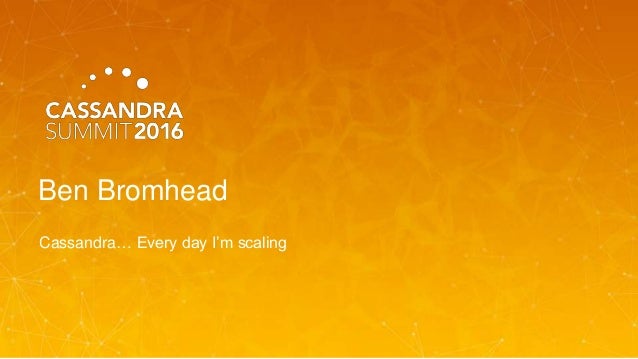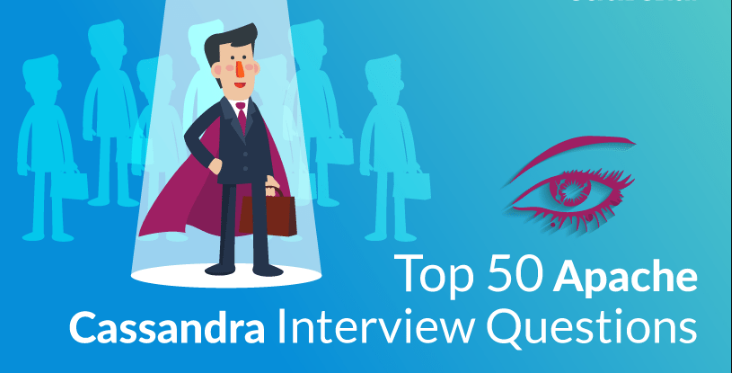Successfully reported this slideshow.
Everyday I’m scaling... Cassandra











































Upcoming SlideShare
Loading in …5
×
-
Be the first to like this
No Downloads
No notes for slide
- 1. Ben Bromhead Cassandra… Every day I’m scaling
- 2. 2© DataStax, All Rights Reserved.
- 3. Who am I and What do I do? • Co-founder and CTO of Instaclustr -> www.instaclustr.com • Instaclustr provides Cassandra-as-a-Service in the cloud. • Currently support AWS, Azure, Heroku, Softlayer and Private DCs with more to come. • Approaching 1000 nodes under management • Yes… we are hiring! Come live in Australia! © DataStax, All Rights Reserved. 3
- 4. 1 Why scaling sucks in Cassandra 2 It gets better 3 Then it gets really awesome 4© DataStax, All Rights Reserved.
- 5. Linear Scalability – In theory © DataStax, All Rights Reserved. 5
- 6. Linear Scalability – In practice © DataStax, All Rights Reserved. 6
- 7. What’s supposed to happen • Scaling Cassandra is just “bootstrap new nodes” • That works if your cluster is under provisioned and has 30% disk usage © DataStax, All Rights Reserved. 7
- 8. What actually happens • Add 1 node • Bootstrapping node fails (1 day) • WTF - Full disk on bootstrapping node? (5 minutes) • If STCS run SSTableSplit on large SSTables on original nodes (2 days) • Attach super sized network storage (EBS) and bind mount to bootstrapping node. © DataStax, All Rights Reserved. 8
- 9. What actually happens • Restart bootstrapping process • Disk alert 70% (2 days later) • Throttle streaming throughput to below compaction throughput • Bootstrapping finishes (5 days later) • Cluster latency spikes cause bootstrap finished but their was a million compactions remaining • Take node offline and let compaction finish • Run repair on node (10 years) • Add next node. © DataStax, All Rights Reserved. 9
- 10. What actually happens © DataStax, All Rights Reserved. 10
- 11. Scalability in Cassandra sucks • Soo much over streaming • LCS and Bootstrap – Over stream then compact all the data! • STCS and bootstrap – Over stream all the data and run out of disk space © DataStax, All Rights Reserved. 11
- 12. Scalability in Cassandra sucks • No vnodes? – Can only double your cluster • Vnodes? – Can only add one node at a time • Bootstrap – Fragile and not guaranteed to be consistent © DataStax, All Rights Reserved. 12
- 13. Why does it suck for you Your database never meets your business requirements from a capacity perspective (bad) and if you try… • You could interrupt availability and performance (really bad) • You could loose data (really really bad) © DataStax, All Rights Reserved. 13
- 14. How did it get this way? It’s actually a hard problem: • Moving large amounts of data between nodes requires just as much attention to it from a CAP perspective as client facing stuff. • New features don’t tend to consider impact on scaling operations • Features that help ops tends to be less sexy © DataStax, All Rights Reserved. 14
- 15. Does it get better? © DataStax, All Rights Reserved. 15 Yes!
- 16. Does it get better? Consistent bootstrap Strongly consistent membership and ownership – CASSANDRA-9667 • Using LWT to propose and claim ownership of new token allocations in a consistent manner • Work in progress • You can do this today by pre-assigning non-overlapping (inc replicas) vnode tokens and using cassandra.consistent.simultaneousmoves.allow=true as a JVM property before bootstrapping your nodes © DataStax, All Rights Reserved. 16
- 17. Does it get better? Bootstrap stability Keep-alives for all streaming operations – CASSANDRA-11841 • Currently implements a timeout, you can reduce this to be more aggressive, but large SSTables will then never stream Resummable bootstrap – CASSANDRA-8942 & CASSANDRA-8838 • You can do this in 2.2+ Incremental bootstrap – CASSANDRA-8494 • Being worked on, hard to do with vnodes right now (try it… the error message uses the word “thusly”), instead throttle streaming and uncap compaction to ensure the node doesn’t get overloaded during bootstrap © DataStax, All Rights Reserved. 17
- 18. Can we make it even better? © DataStax, All Rights Reserved. 18 Yes!
- 19. Can we make it even better? © DataStax, All Rights Reserved. 19 • Let’s try scaling without data ownership changes • Take advantage of Cassandras normal partition and availability mechanisms • With a little help from our cloud providers!
- 20. Introducing token pinned scaling © DataStax, All Rights Reserved. 20 • Probably needs a better name • Here is how it works
- 21. Introducing token pinned scaling © DataStax, All Rights Reserved. 21 With the introduction of: • Partitioning SSTables by Range (CASSANDRA-6696) • Range Aware Compaction (CASSANDRA-10540) • A few extra lines of code to save/load a map of token to disks (coming soon) Cassandra will now keep data associated with specific tokens in a single data directory, this could let us treat a disk as a unit in which to scale around! But first what do these two features actually let us do?
- 22. Introducing token pinned scaling © DataStax, All Rights Reserved. 22 Before Partitioning SSTables by Range and Range Aware Compaction: 1 - 100 901 - 1000 1401-1500 Disk0 Disk1 SSTables
- 23. Introducing token pinned scaling © DataStax, All Rights Reserved. 23 After Partitioning SSTables by Range and Range Aware Compaction: 1 - 100 901 - 1000 1401-1500 Disk0 Disk1 SSTables Data within a token range is now kept on a specific disk
- 24. Introducing token pinned scaling © DataStax, All Rights Reserved. 24 Your SSTables will converge to contain a single vnode range when things get big enough 1 - 100 901 - 1000 1401-1500 Disk0 Disk1 SSTables
- 25. Leveraging EBS to separate I/O from CPU © DataStax, All Rights Reserved. 25 • Amazon Web Services provides a networked attached block store called EBS (Elastic Block Store). • Isolated to each availability zone • We can attach and reattach EBS disk ad-hoc and in seconds/minutes
- 26. Adding it all together © DataStax, All Rights Reserved. 26 • Make each EBS disk a data directory in Cassandra • Cassandra guarantees only data from a specific token range will exist on a given disk • When throughput is low attach all disks in a single AZ to a single node, specify all the ranges from each disk via a comma separated list of tokens. • Up to 40 disks per instance! • When load is high, launch more instances and spread the disks across the new instances.
- 27. Adding it all together © DataStax, All Rights Reserved. 27 • Make each EBS disk a data directory in Cassandra sda sdd sdb sde sdc sdf Amazon EBS
- 28. Adding it all together © DataStax, All Rights Reserved. 28 • Cassandra guarantees only data from a specific token range will exist on a given disk Amazon EBS
- 29. Adding it all together © DataStax, All Rights Reserved. 29 • When throughput is low attach all disks in a single AZ to a single node Amazon EBS 200 op/s
- 30. Adding it all together © DataStax, All Rights Reserved. 30 • When load is high, launch more instances and spread the disks across the new instances. Amazon EBS 10,000 op/s
- 31. How it works - Scaling © DataStax, All Rights Reserved. 31 • Normally you have to provision your cluster at your maximum operations per second + 30% (headroom in case your get it wrong). • Provision enough IOPS, CPU, RAM etc • Makes Cassandra an $$$ solution Provisioned workload Actual workload
- 32. © DataStax, All Rights Reserved. 32
- 33. How it works - Scaling © DataStax, All Rights Reserved. 33 • Let’s make our resources match our workload Provisioned IOPS workload Actual workload Provisioned CPU & RAM workload
- 34. How it works - Scaling © DataStax, All Rights Reserved. 34 • Let’s make our resources match our workload Provisioned IOPS workload Actual workload Provisioned CPU & RAM workload
- 35. How it works - Consistency © DataStax, All Rights Reserved. 35 • No range movements! You don’t need a Jepsen test to see how bad range movements are for consistency. • Tokens and ranges are fixed during all scaling operations • Range movements are where you see most consistency badness in Cassandra (bootstrap, node replacement, decommission) and need to rely on repair.
- 36. How it works - Consistency © DataStax, All Rights Reserved. 36 • Treats Racks as a giant “meta-node”, network topology strategy ensures replicas are on different racks. • AWS Rack == AZ • As tokens for a node change based on the disk they have, replica topology stays the same • You can only swap disks between instances within the same AZ • Scale one rack at a time… scale your cluster in constant time! • If you want to do this with a single rack, you will have a bad time
- 37. How it works - Consistency © DataStax, All Rights Reserved. 37 1,5,10 2,6,11 3, 22, 44 4,23,45 102,134,167 101,122,155 1,2,3,4,5,6,10,11,22,23,44,45,101 …
- 38. How it works - Consistency © DataStax, All Rights Reserved. 38 1,5,10 2,6,11 3, 22, 44 4,23,45 102,134,167 101,122,155 1,5,10 2,6,11 3,22,44 4,23,45 102,134,167 101,122,155
- 39. How it works - TODO © DataStax, All Rights Reserved. 39 Some issues remain: • Hinted handoff breaks (handoff is based on endpoint rather than token) • Time for gossip to settle on any decent sized cluster • Currently just clearing out the system.local folder to allow booting • Can’t do this while repair is running… for some people this is all the time • You’ll need to run repair more often as scaling intentionally introduces outages • Breaks consistency and everything where RF > number of racks (usually the system_auth keyspace). • More work needed!
- 40. How it works – Real world © DataStax, All Rights Reserved. 40 • No production tests yet • Have gone from a 3 node cluster to a 36 node cluster in around 50 minutes. • Plenty left to optimize (e.g. bake everything into an AMI to reduce startup time) • Could get this down to 10 minutes per rack depending on how responsive AWS is! • No performance overhead compared to Cassandra on EBS. • Check out the code here: https://github.com/benbromhead/Cassandra/tree/ic-token- pinning
- 41. How it works – Real world © DataStax, All Rights Reserved. 41 • Really this is bending some new and impending changes to do funky stuff
- 42. Questions?
- 43. Questions?
Public clipboards featuring this slide
No public clipboards found for this slide







